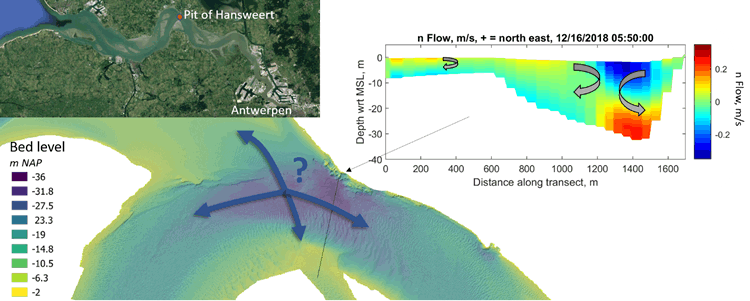Y. Huismans1*, B. Huisman1, A. Colina Alonso1,2, H. van der Vegt1, M. van der Wegen1,3
1 Deltares,
2 TU Delft,
3 IHE Delft,
Introduction
The Western Scheldt has a large ecological value and is classified as Natura 2000 area. The estuary is furthermore of large economic interest as it provides an important navigation route. To maintain the navigation route, dredging is carried out. The dredged sediment is disposed back into the system, in the side- and main channels and on the edges of tidal flats. To optimize the disposal strategy for both ecology and dredging efforts, a strategy is being considered in which a large part of the sediment is disposed in deep pits in the main channel. In this study, the effects on the morphological developments are investigated.
Methods
The study focusses on the sediment dynamics around the pit of Hansweert, one of the largest pits. This site serves as a pilot location. In the past years, three times 1 Mm3 of sediment is disposed in this pit. The hydrodynamics and sediment dynamics have been closely monitored by e.g. ADCP measurements, 42 multibeam surveys and sediment samples. To analyse the morphodynamic response to the disposal, three methods are combined. First, multibeam surveys are used to track the volume changes in each sub-domain. Secondly, detailed 3D hydrodynamic modelling is carried out to understand the local flow patterns and predict the impact on short-term sediment transport (hours to days). Thirdly, 2D morphodynamic modelling is applied to infer how the sediment spreads on a larger scale (kilometres) and timeframe (years), once it has left the pit.
Results
The analyses show that the sediment transport is flood dominated (directed to the east). After the disposal of sediment, all sediment leaves the pit within several months to a year. Most sediment is transported towards the inner bend (~80-95%). Model results and bed level measurements suggest that a large share of this sediment is transported in suspension. From the inner bend, sediment is either transported eastward towards the "Drempel van Hansweert" or flows back into the pit via a flow slide. Due to accretion of the inner bend, the flow cross section decreases, which is compensated by erosion in the adjacent channel and outer bend. About 5 to 20% of the sediment is transported in other directions. Delft3D indicates this sediment can end up further away in low energy areas, but effects are relatively small in comparison to the natural changes in the estuary. Similar morphological processes are expected to play a role for other bends of the Western Scheldt.
These findings enhance our understanding of the physics of estuaries and support policy decisions on the sustainable management of the system.

Figure 1 Bed level around the Pit of Hansweert, a pilot location in which 3 Mm3 sediment is disposed for testing a new disposal strategy. Inset 1: overview Western Scheldt (Source: Google Earth). Inset 2: flow in n-direction.
I. Surname1*, F.N. Another-Surname2 , Y. Next-Surname2
1 University Name, Country; 2 Organization Name, Country
* Corresponding author: mail.name@organization.org


